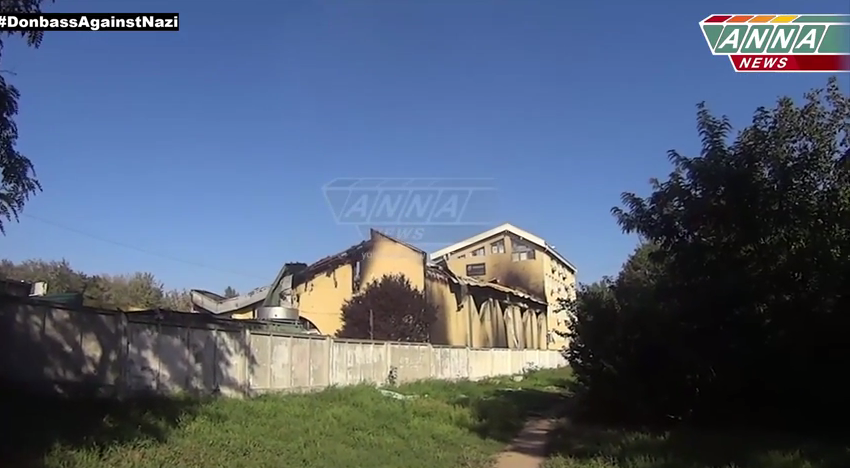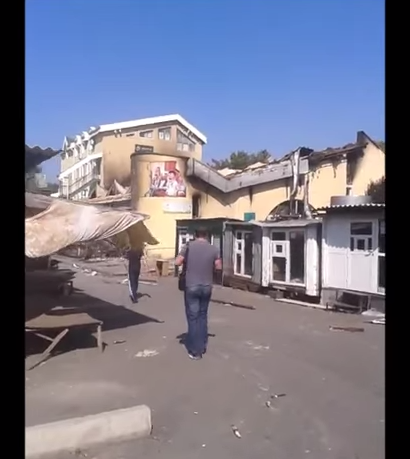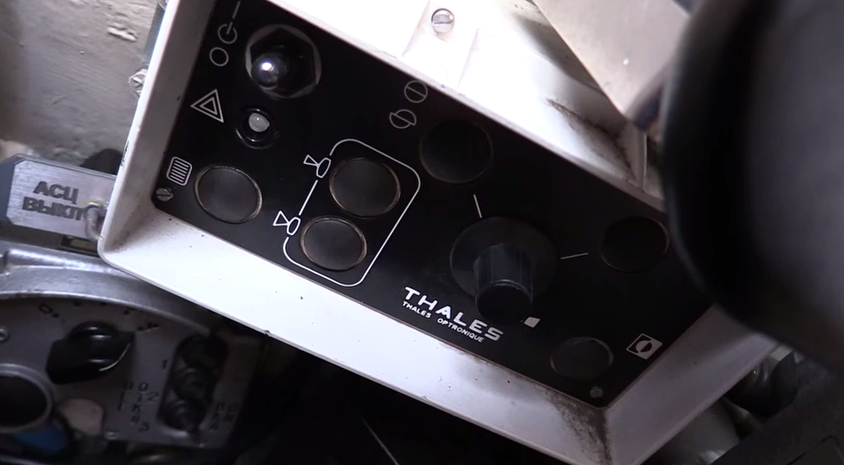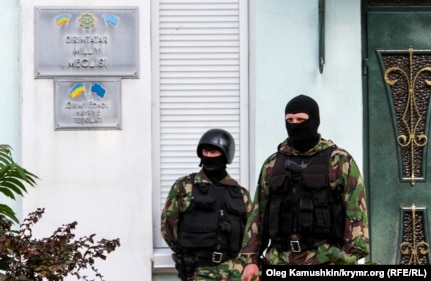Yesterday’s liveblog can be found here. An archive of our liveblogs can be found here. For an overview and analysis of this developing story see our latest podcast.
Please help The Interpreter to continue providing this valuable information service by making a donation towards our costs.
View Ukraine: April, 2014 in a larger map
For links to individual updates click on the timestamps.
For the latest summary of evidence surrounding the shooting down of flight MH17 see our separate article: Evidence Review: Who Shot Down MH17?
Below we will be making regular updates so check back often.
The self-proclaimed “Donetsk People’s Republic” (DPR) and “Lugansk People’s Republic” (LPR) have announced they are creating the “Unified Army of Novorossiya” (OAN), according to a statement on DNR Today, which is said to be “the official site and press center of the Government and Supreme Council of the DPR.”
The statement said the “armies of the DPR and LPR” would merge into the OAN which will “enable the armed forces of Novorosssiya to resolve the most complex tasks in defending their native land from Ukrainian fascism and also help bring liberation to the land which was enslaved by Nazi filth.”
The “Law on the Special Status of Certain Districts in Donetsk and Lugansk Regions” provides for “the establishment of local militias” but it was not clear whether that meant regular police or DPR-style militias, and whether there would be armed forces.
The “Novorossiya” statement is as follows (translation by The Interpreter)
Fulfilling the will of the people, expressed by representatives of the deputies’ corps of Novorissya, and also, taking into account the extreme necessity of creating united armed forces of Novorossiya, enabling the resolution of the task of both defense of the republics of the DPR and LPR, and also the ensuing offensive, in order to liberate the peoples of Novorossiya and Ukraine from the yoke of Nazism and oligarchs,
We, commanders of the voluntary military formations of the peoples’ republics, acting on the basis of the population will,
1) passed a decision to create the United Armed Forces of Novorossiya
2) passed a decision to appoint Lt. Gen. Ivan Anatolyevich Korsun as Commander-in-Chief of the Armed Forces;
3) passed a decision to assign Lt. Gen. Ivan Anatolyevich Korsun, Commander-in-Chief of the Armed Forces of Novorossiya to conduct a complex of necessary organizational activities to implement this resolution in the shortest time possible.
So now the aspirational “Novorossiya” has a united parliament and a united army, but the two “people’s republics” have not merged and remain as distinct “city-states.”
Note that the job of overseeing the reorganization of the forces of “Novorossiya,” once said by Prime Minister Aleksandr Zakharchenko to be offered to Col. Igor Strelkov, is now given to another figure, Lt. Gen. Korsun.
Not much has been heard from him before as the independent Russian news site grani.ru says and yet a recent interview with him in the local media reveals him to be an extreme hardliner not only with aspirations beyond the Lugansk and Donetsk to other western Ukrainian cities, but with determination to install a Soviet-style economy with nationalization of all private industry and draconian police practices to root out corruption, starting in ‘Novorossiya”s own ranks. (See our Russia This Week blog for excerpts.)
The statement on the OAN has been signed by Lt. Gen. Igor Bezler, commander of the Gorlovka Militia, Aleksandr Khodakovsky, commander of the Vostok Battalion, Aleksandr Matyushin, commander of the Varyag Battalion; Konstantin Kuzmin, commander of the Shakhtyorsk Division, and V. Khalin.
The first two are well known to regional and Western media, but the last three much less so. (See our Russia This Week blog for more background and the reaction of deposed Col. Igor Strelkov.)
Nothing is said in the statement about Aleksandr Zakharchenko, who was brought in as “prime minister” or the current commander-in-chief, Vladimir Kononov, who had the nom de guerre “Tsar,” which has interpreted by some to mean that a coup has taken place in “Novorossiya.”
President Petro Poroshenko knelt before a memorial wreath, and people placed signs and candles in his memory.
Translation: Above is the number of journalists who died during independence, and below — you know what. We remember.
The candles below spell out with Ukrainian letters “Giya” which was Georgiy’s nickname.
Translation: Today in Kiev respects are paid to the memory of Georgiy Gongadze and other killed journalists.
Gongadze’s murder rocked Ukraine under the leadership of then President Leonid Kuchma and became a cause celebre for those seeking press freedom and safety for investigative journalists. The journalist went missing and then his decapitated body was found later in a forest.
Audiotapes later were released by opposition politician Oleksandr Moroz, made by Kuchma’s former bodyguard, Nikolai Melnichenko, in which Kuchma, Volodymyr Lytvyn and other officials were heard discussing the need to silence Gongadze over his reports of high-level corruption.
Right before he was supposed to testify in the murder investigation, former Interior Minister Yuriy Kravchenko was killed, and four of his subordinates were later charged and sentenced with Gongadze’s murder. Gongadze’s family believe the masterminds of the murder were never caught. Mass protests then broke out in September 2002 on the second anniversary of Gongadze’s death, seeking justice and the resignation of Kuchma. Repeated efforts to link Kuchma to the murder through Ukrainian courts have failed.
In 2013, the first deputy prosecutor general said he had enough evidence to confirm Kuchma’s responsibility for ordering Gongadze’s assassination; on 9 July 2014, Ukrainian Prosecutor General Vitaliy Yarema stated that his office would revisit investigations “that were dropped unlawfully”, including the Gongadze murder.
In an editorial for the Kyiv Post, Brian Bonner wrote on May 27 that the “acid test” for Poroshenko would be putting Kuchma on trial:
Poroshenko should let prosecutors go ahead and put Kuchma on trial for ordering the Sept. 16, 2000 murder of journalist Georgiy Gongadze, who was killed to send a message to everyone else that free speech and public criticism of a president will not be tolerated.
All evidence in the last nearly 14 years points to Kuchma as having ordered the crime. Prosecutors have said as much. He claims he is innocent.
There is only one fair way to find out: Put him on trial and let the evidence come out publicly in a fair, judicial hearing. The charges have been blocked for political reasons. And, for political reasons, the trial must go ahead if Ukraine is to ever start coming to grips with a sorry past so it can move forward to a brighter future.
The mere act of putting Kuchma on trial will signal to everyone in Ukraine that business as usual is over and that no one is above the law, especially when it comes to murder.
Kuchma was named a negotiator to the Minsk talks with Russian-backed separatists which concluded a ceasefire agreement September 5.
There have been multiple reports of shelling in the separatist-held city of Donetsk today, despite the ceasefire.
This morning, Donetsk news site 62.ua reported that shelling could be heard in the Leninsky, Petrovsky and Kirovsky districts of the city.
There as no suggestion in their report as to which side was responsible for these attacks.
Andrei Lysenko, the spokesman for the Ukrainian National Security and Defence Council (SNBO), told reporters at a briefing today that separatist and Russian forces were continuing to shell the Kuybyshevsky and Kievsky districts with heavy weapons.
Lysenko said that 3 civilians had been killed over the past day.
Meanwhile, the pro-separatist Anna News YouTube channel, uploaded a video today, which it claimed showed the burnt out remains of the Budyonnovsky meat market, to the south-east of the city centre, after being shelled by Ukrainian forces.
However the video in fact appears to show the Putilovsky market just south-east of the airport, which has been under frequent attack by Russian forces, on the other side of the city, which was struck by shelling on September 14.
Here is a quick comparison of a still from the Anna News video, and one from Putilovsky uploaded yesterday:


The Verkhovna Rada has passed the much-called-for lustration bill with 231 deputies voting in favour, none against or abstaining, and 15 absent.
Ukrainska Pravda reports (translated by The Interpreter):
Previously, deputies had failed to vote on the bill at its second reading, but they were able, after several attempts, to return to it.
The Speaker of parliament, Oleksandr Turchynov, told deputies that he would not let them out of the hall until the issue of lustration is passed.
Oleh Tyhanybok, the leader of the Svoboda party, urged deputies to accept “this, less strict version, lest a harsher one be passed tomorrow.”
Outside the Rada, protesters had gathered, both to call for the passing of the bill, and to express anger at the granting of a special status of self-governance to the eastern regions under separatist control, which has been seen by many as capitulation to Russian demands.
Translation: In front of the Rada, a small scuffle between police and protesters, eggs are flying at the police.
In scenes echoing (on a vastly reduced scale) the Maidan protests of the winter, protesters set fire to a pile of tyres:
Translation: They’ve now set fire to tyres in front of the Rada itself
Flags of the far-right Praviy Sector and the Svoboda party are visible amongst the protesters.
Vitaliy Zhuravsky, a former member of deposed President Viktor Yanukovch’s Party of Regions, author of the January 16 bill that restricted Ukrainians’ right to protest, was seized by protesters and thrown into a bin outside the parliament.
Shoigu spoke of the “growing necessity” for such a group as the “Rapid Trident- 2014” exercises take place in nearby Lvov Region with Ukraine, US, Azerbaijan, Bulgaria, Canada, Germany, UK, Latvia, Lithuania, Moldova, Norway, Poland, Romania and Spain (translation by The Interpreter):
“The military-political situation in the South West strategic direction from early this year has substantially changed. This is largely connected with the expansion of the territory of the South Military District after Crimea’s entry into Russia. Moreover, the situation in Ukraine has become sharply aggravated and there is an increase of a foreign military presence in immediate proximity to our border.”
Russia began staging large military exercises near the Ukrainian border shortly before the forcible annexation of the Crimea and has repeatedly staged such exercises as well as amassed large amounts of armor near the border. Russian then began making regular invasions of Ukraine in August.
Shoigu said that by 2020, a “full-fledged and self-sufficient” group would be deployed on the Crimean peninsula.
When “little green men” began to make their appearance in the Crimea in February, Shoigu discounted their relationship to Russian armed forces, although later President Vladimir Putin himself admitted their presence.
The following video was uploaded by Russia’s Vesti yesterday. In it, separatists show off their “trophy,” a T-72 tank they claim to have captured from Ukrainian forces.
The video is described thus (translated by The Interpreter):
The first such vehicle captured by the militia. This T-72 has been modernised, with the near maximum combat outfit. The crew abandoned the tank after being struck by a shell in the side and turret. The damage has not affected the combat capability of the vehicle. The internal electronics are of foreign manufacture. They allow one to track the movements of allied tanks in the group. This is a so-called command tank. Soon enough, it will join the ranks of the armed forces of the DNR.
The problem for the separatists is, however, that this tank is clearly a T-72B3, a model that has not been exported outside Russia and serves extensively in Russia’s armed forces.
Joseph Dempsey, an analyst at the International Institute of Strategic Studies, who has previously written on Russia’s deployment of this very model to their border with Ukraine, has confirmed this identification:
Similar tanks, have been seen operating in eastern Ukraine on several occasions, having been located near Sverdlovsk, Krasnodon and at a ‘Novorossiya’ parade in Perevalsk. Dempsey confirmed to the BBC that the tanks filmed near Sverdlovsk were T-72BMs and stressed that these tanks had not been exported.
The attention drawn by Vesti to the foreign electronics, as seen in the screenshot below of a French-made Thales Optotronique sight, only serves as further evidence of the Russian origin of this vehicle.

Thales have had well-publicised contracts with Russia to install thermal imaging equipment, as described here.
The tank is without doubt, recently imported from Russia and is not from Ukrainian military stocks.
It is possible however, that the tank was indeed captured from Ukrainian forces.
Ukraine has captured a number of Russian tanks and other armoured vehicles during engagements. Yesterday, for example, Andrei Lysenko, the spokesman for the Ukrainian National Security and Defence Council, told reporters that, following an attempt by Russian or Russian-backed fighters to capture Donetsk Airport, one Russian tank was captured.
More relevant though, is an account, published by Censor.NET’s Yuriy Butusov, by Ukrainian Colonel Evgeniy Sidorenko.
The report has been translated into English by Aleks Burduli and is available to read here on Burkonews.info.
Sidorenko, who fought in and escaped the carnage in Ilovaisk, describes capturing a Russian T-72B3 tank:
Nevertheless, our battle group with the help of a BMP disabled a Russian tank. I was not a participant in this fight, but I was immediately summoned to inspect the trophy. The tank crew left the vehicle and ran away together with other Russian armored vehicles.
I climbed into the tank and found that it is the latest modification of the Russian T-72B-3, which entered service in 2012. The main modification is the thermal sight “SOSNA-U” for the commander and the gunner. The sights on the tank were damaged by our fire, but after a small repair it was possible to use them, although the thermal sight and gun vertical stabilizer did not work. The rest of the tank was fully functional.
Here we should note that the SOSNA-U sighting system described above does indeed include the Thales Catherine FC thermal imaging system seen above.
According to documents the tank belonged to the military section of the Russian Federation № 54096 – this is the 8th Motorized Rifle Brigade, 3rd Tank Company. The company commander was listed as Rashitov A.R., and the tank commander as Sergeant Goncharov. I took the tank into service of our group, and personally drove it to our position. During the break out this tank saved the lives of many of our soldiers, and me personally.
Sidorenko and his crew set off to escape from Ilovaisk in the tank, and travelled near the front of the column, using the tank to suppress enemy fire, destroying a Russian BMP infantry fighting vehicle.
Eventually however, Sidorenko and his crew were forced to abandon the vehicle:
Our tank was fatally hit after about 22 kilometers from our start position. We had to break between Russian positions. By that time we had already been hit on the side and we had received multiple injuries, secondary tank armor fragments. All monitoring devices and sight were completely broken. We almost broke out, but then we received a direct hit from a tank gun. Martyniuk banged himself of a surveillance device and lost consciousness.
Under the cover of machine gun fire, I pulled Evgenyi from the tank and bandaged him. Luckily his eyes remained intact, although he had numerous shrapnel wounds to the face. It was impossible to repair the vehicle, so we had to leave it.
The Vesti video gives no hint as to the location of the vehicle, and we cannot say that we see the damage suggested by Sidorenko on this particular vehicle. However this report, if true, would serve as an example of how separatist forces could apparently capture a Russian tank in Ukrainian service.
The alternate possibility is of course, that the tank has never been captured, but was painted with the twin white stripes used by Ukrainian forces to identify friendly vehicles to provide cover for the arrival of such equipment.
Masked gunmen and police officers conducted a raid this morning on the Crimean Tatar Mejlis in Simferopol, Russian-occupied Crimea.
Reporting from the site, an RFE/RL correspondent said 10 police officers and six armed, masked men in military uniform surrounded the Mejlis in Crimea’s capital, Simferopol, and were not letting anyone enter or leave the building.
The Mejlis is the self-governing body of the Crimean Tatars, most of whom opposed Russia’s annexation of Crimea from Ukraine in March and many of whom boycotted local elections on September 14.
Police inside the building on September 16 were said to be searching the offices of the Crimean Tatar newspaper “Avdet” (Return).
Police also searched the home of Mejlis member Eskender Bariyev and confiscated his computers.

Today, almost 10 months after now-deposed President Yanukovych suspended preparations for the signing, the Ukrainian and European parliaments have simultaneously ratified the Association Agreement.
Unlike the Rada, there was dissent in the European Parliament with the parliamentary press service reporting 535 in favour, 127 against and 35 abstentions.
Far-right and eurosceptic parties, who have often been publicly sympathetic to Putin’s Russia were among the dissenters.
Ukraine’s parliament, the Verkhovna Rada, has passed bills put forward by President Petro Poroshenko on the assignment of a special status and an amnesty for the regions of eastern Ukraine under Russian-backed separatist occupation.
Ukrainska Pravda reports (translated by The Interpreter):
277 deputies voted for the special status bill, 287 for the implementation of an amnesty.
According to the law on the special status of local self-government in certain districts of the Donetsk and Lugansk oblasts, local elections will be held on December 7, 2014.
Earlier, in the document distributed to deputies on Monday, Poroshenko had proposed to hold elections on November 9, 2014.
According to this law, a special status of local self-governance will be implemented for three years in certain districts of the Donetsk and Lugansk oblasts, which will include the districts, cities, towns and villages located, at the time of the enforcement of this law, in within the area in which the ATO is being conducted.
Other elements of the bill of amnesty and the proposals for economic relief and the establishment of local militias are discussed in yesterday’s post on the first disseminated draft of the bill.
Yesterday the leadership of the separatist ‘Donetsk People’s Republic’ appeared to be sending mixed signals with regards to the special status bill.
Earlier, the ‘official’ DNR Twitter account posted:
Translation: The DNR does not consider the law proposed by Poroshenko on the special status of the regions of Donbass to be relevant.
However by the end of the evening, their position appeared to have softened somewhat:
Translation: The #DNR authorities are studying the draft law of the “special status” of Donbass.